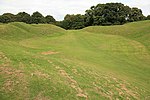Cirencester Deer Park School
Academies in GloucestershireCirencesterEducational institutions established in 1966Gloucestershire building and structure stubsSecondary schools in Gloucestershire ... and 2 more
South West England school stubsUse British English from February 2023
Cirencester Deer Park School is a secondary school with academy status in Cirencester, Gloucestershire, England. It is at the top of Tetbury Hill, an area which had been the site of a World War II American Army Hospital, in Cirencester Park.
Excerpt from the Wikipedia article Cirencester Deer Park School (License: CC BY-SA 3.0, Authors).Cirencester Deer Park School
Stroud Road, Cotswold District
Geographical coordinates (GPS) Address Phone number Website External links Nearby Places Show on map
Geographical coordinates (GPS)
| Latitude | Longitude |
|---|---|
| N 51.7125 ° | E -1.9877777777778 ° |
Address
Cirencester Deer Park School
Stroud Road
GL7 1XB Cotswold District
England, United Kingdom
Open on Google Maps









